Biography of Leon Maiolo: A Life of Grit, Routine, and Resilience
Leon Samuel Maiolo was born on July 19, 1921 to Leo Maiolo and Esther Constantine Maiolo. His father, Leo, was a World War I veteran, instilling in Leon a sense of duty and resilience from an early age. The family lived on Water Street, right along the banks of the Black River in Watertown, New York. Growing up by the river, Leon developed a fearless connection to nature. As a young boy, he often swam in the Black River, testing himself against its strong currents. The challenges of the river likely cultivated the physical strength and determination that would later define him in both work and service.
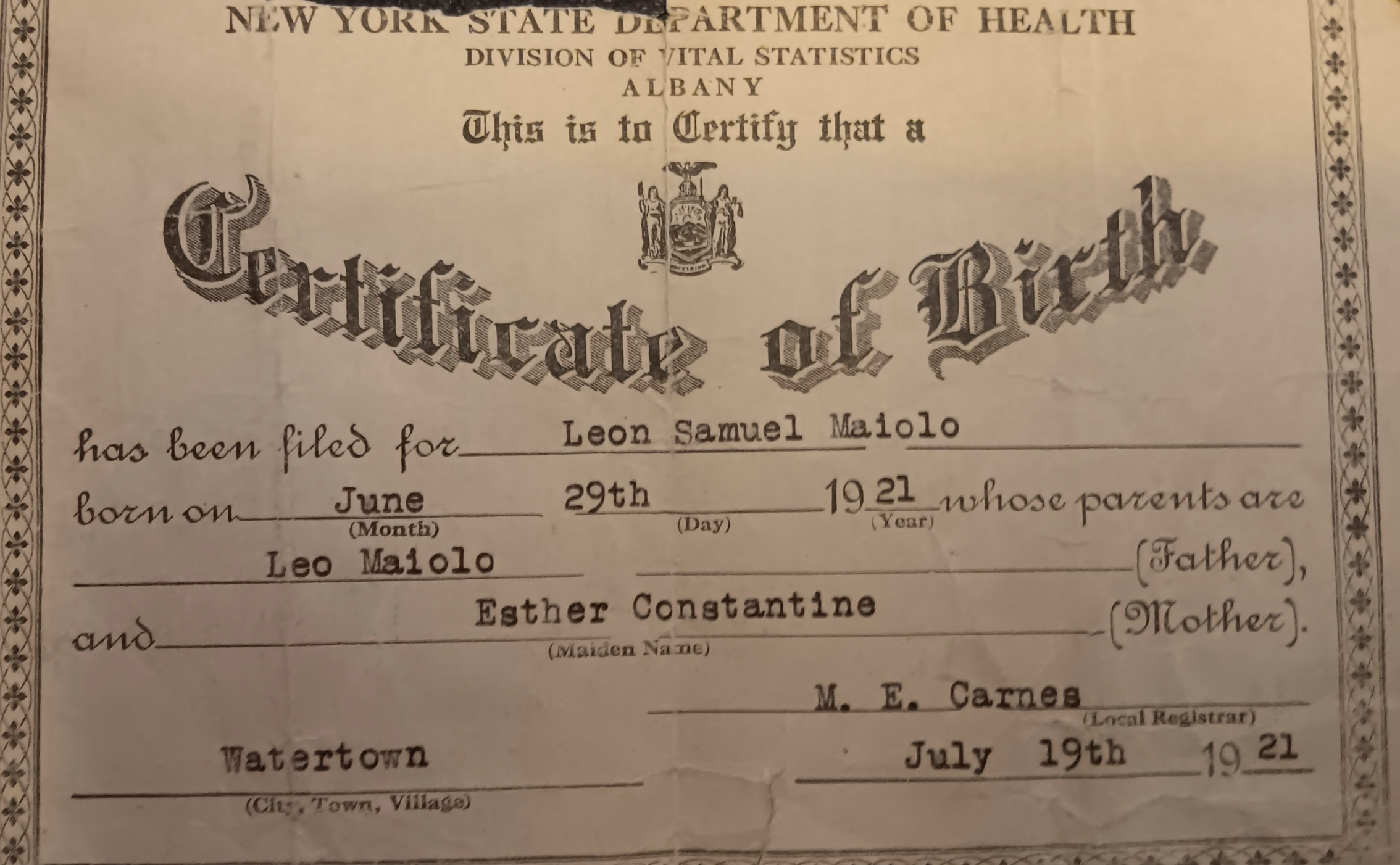
Leon attended high school in Watertown, where he wrestled on the school’s wrestling team. With his distinct accent, he would later describe this as “wrastling,” a term that became part of his personal lexicon, reflecting his strong regional roots. Wrestling was more than just a sport for Leon; it was an embodiment of the tenacity and grit that marked his character throughout his life.
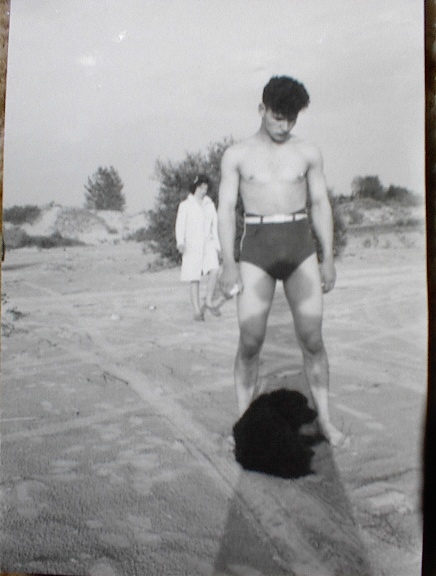
Leon during Wrestling Years
As a child, Leon also enjoyed hunting and fishing, often spending long hours outdoors, skills that would stay with him well into adulthood. During some summers, he visited his Uncle Constantine’s farm on Wellesley Island, where he took on farm work, especially haying. These summers taught him the value of hard work and introduced him to the rhythms of farm life. Leon thrived in this setting, enjoying the hands-on work and the sense of accomplishment that came with it.
His father, Leo, worked at the same stone quarry that Leon would later call his own workplace for many years. Leo’s job was conveniently close, as Water Street led directly to the quarry. Growing up in this environment, Leon developed a familiarity with the quarry that would shape his future. It was a family tradition of sorts—a connection to the land, work, and community. By his teenage years, Leon had met Ruth, who would later become his lifelong companion. They married when Leon was 20, December 28, 1941, and Ruth was 18, solidifying their bond before the events of World War II would take him overseas.
Joining the War and Heroism in France
In 1943, at the age of 22, Leon was drafted into World War II, joining the ranks of countless young men sent to fight abroad. He was assigned to the 14th Armored Division and deployed to France, where he would serve until the end of the war in 1945. During his time in combat, Leon demonstrated exceptional bravery, earning both the Bronze Star and the Purple Heart for his actions.
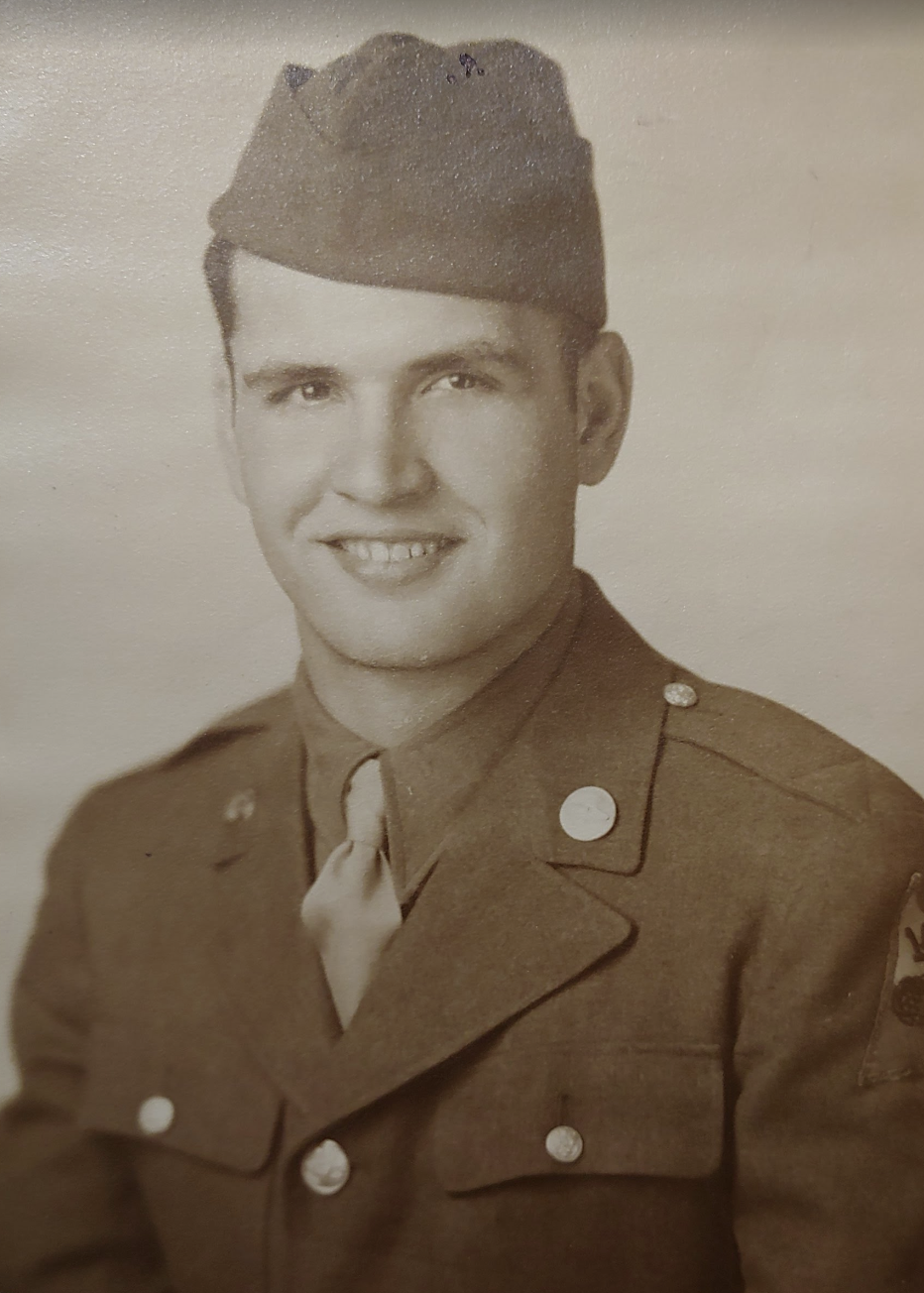
Leon Maiolo, World War II Enlistment Photo
Leon served as a tank commander in France, a role that placed him in the top hatch of the tank, directing its movement and strategy. It was during one of these missions that he encountered a near-fatal booby trap. The Germans had placed a wire trap across the road, specifically designed to strike the tank commander as the vehicle advanced, aiming to decapitate whoever was in the top position. Leon, with his keen awareness, spotted the wire just in time and shouted down for the driver to stop the tank. However, the tank couldn’t come to a complete halt before the wire reached Leon, striking him in the face and mouth and ripping out all of his teeth. His quick reaction saved him from a fatal injury, though the incident left him severely wounded. For this injury in combat, he was awarded the Purple Heart, a testament to the personal sacrifice he made on the battlefield.
The Bronze Star, another prestigious recognition, was awarded for an act of bravery during intense combat near Hatten, France, on January 13, 1945. Leon’s platoon faced heavy fire and was in desperate need of reinforcement to hold their position. In the midst of the battle, Leon spotted an abandoned tank destroyer nearby. Despite the enemy fire, he moved toward the vehicle with the intent to reinforce his platoon. The tank destroyer failed to start, but Leon’s determination didn’t waver. Unable to effect immediate repairs, he used the vehicle’s power as cover, drawing the enemy’s attention away from his platoon. His actions allowed his fellow soldiers to maneuver to a safer location while minimizing casualties.
This selfless act of courage not only saved lives but also earned him the Bronze Star, a recognition for “heroic achievement” in combat. This highlighted Leon’s courage in the face of heavy enemy fire and his unwavering resolve to support his unit under extreme conditions. His bravery during this mission exemplified the highest standards of service, reinforcing his reputation as a soldier who would risk his own safety for the well-being of his comrades.
Both the Bronze Star and the Purple Heart reflect the dedication, bravery, and resilience that Leon exhibited throughout his life. His wartime experiences, marked by moments of intense danger and acts of selflessness, shaped him profoundly, leaving him with not only physical scars but also a deep sense of pride and honor. After returning home, these decorations served as reminders of his commitment and courage, values he would carry into his family life and work at the quarry.
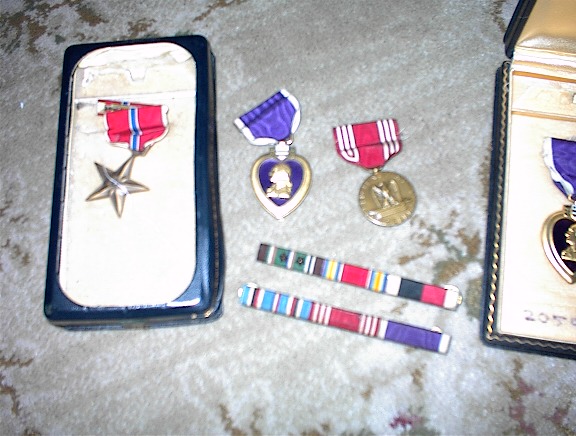
Leon’s War Medals
After serving in World War II from 1943 to 1945, stationed in France, Leon Maiolo returned to Watertown, New York, ready to build a life grounded in hard work and family. His experiences in the war had instilled in him a resilience and determination that would carry through his entire life. Leon settled into a job at the General Crushed Stone Company, a place that would become central to his identity, as he carved out a life in Watertown just a few miles from his home.
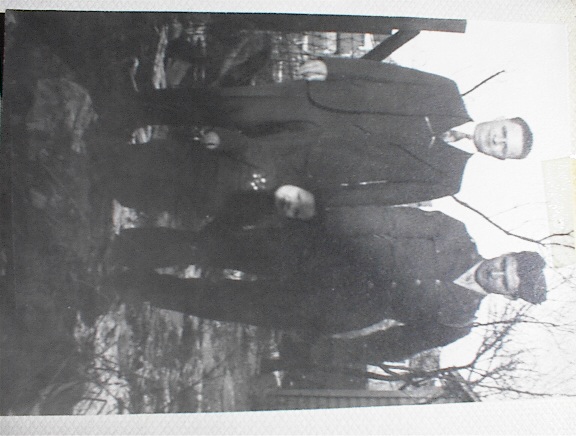
Leon with his father Leo
Early Family Life and Tragedy
Leon’s return from World War II marked a bittersweet transition. While the war had introduced him to the challenges of military life in France from 1943 to 1945, he came home to a family already shaped by both joy and sorrow. His first son, Tim, had been born in 1942, a year before Leon went overseas. As Leon served abroad, Tim was a young boy, just beginning to form memories that would shape his understanding of the father he barely knew during his earliest years. The gap between father and son was profound, as Leon missed out on the first pivotal moments of Tim’s childhood. By the time he returned, Tim was nearly three years old, and Leon would spend time reconnecting with his firstborn and stepping fully into his role as a father.
In 1945, as Leon was concluding his service and preparing to return home, tragedy struck the family. Ruth gave birth to a baby girl, Sheila Rose Maiolo, on January 12, 1945. However, Sheila Rose’s life was heartbreakingly brief; she lived only 10 days due to a congenital heart problem and never left the hospital. This loss weighed heavily on Leon and Ruth. They hadn’t even had the chance to bring Sheila Rose home, and their hopes for their growing family were dashed in a matter of days. For Leon, who had seen the hardships of war, this personal tragedy was a painful contrast to the challenges he had faced in France.
Despite the sorrow, Leon and Ruth found strength in each other. The resilience he had developed during his wartime service, though different from the emotional toll of family loss, helped him move forward. In 1946, just a year after the loss of Sheila Rose, their daughter, Terry, was born. The close age gap between Tim and Terry meant that Leon now had two young children to raise, providing a renewed sense of purpose. With the war behind him, he could now focus on rebuilding his life and creating a stable home for his family.
By 1959, Leon and Ruth’s family grew once more with the birth of their youngest son, Leon Jr. The nearly 17-year gap between Tim, the eldest, and Leon Jr., the youngest, created a unique family dynamic. Tim and Terry, with their childhoods shaped by the immediate post-war years and their father’s reintroduction into civilian life, were already well into adolescence by the time their younger brother arrived. Leon Jr. was raised in a household that had been seasoned by both the scars of loss and the resilience that had defined Leon and Ruth’s journey together. Leon Sr. took his wartime discipline and applied it to his role as a father, providing structure and security for his children in a post-war world.
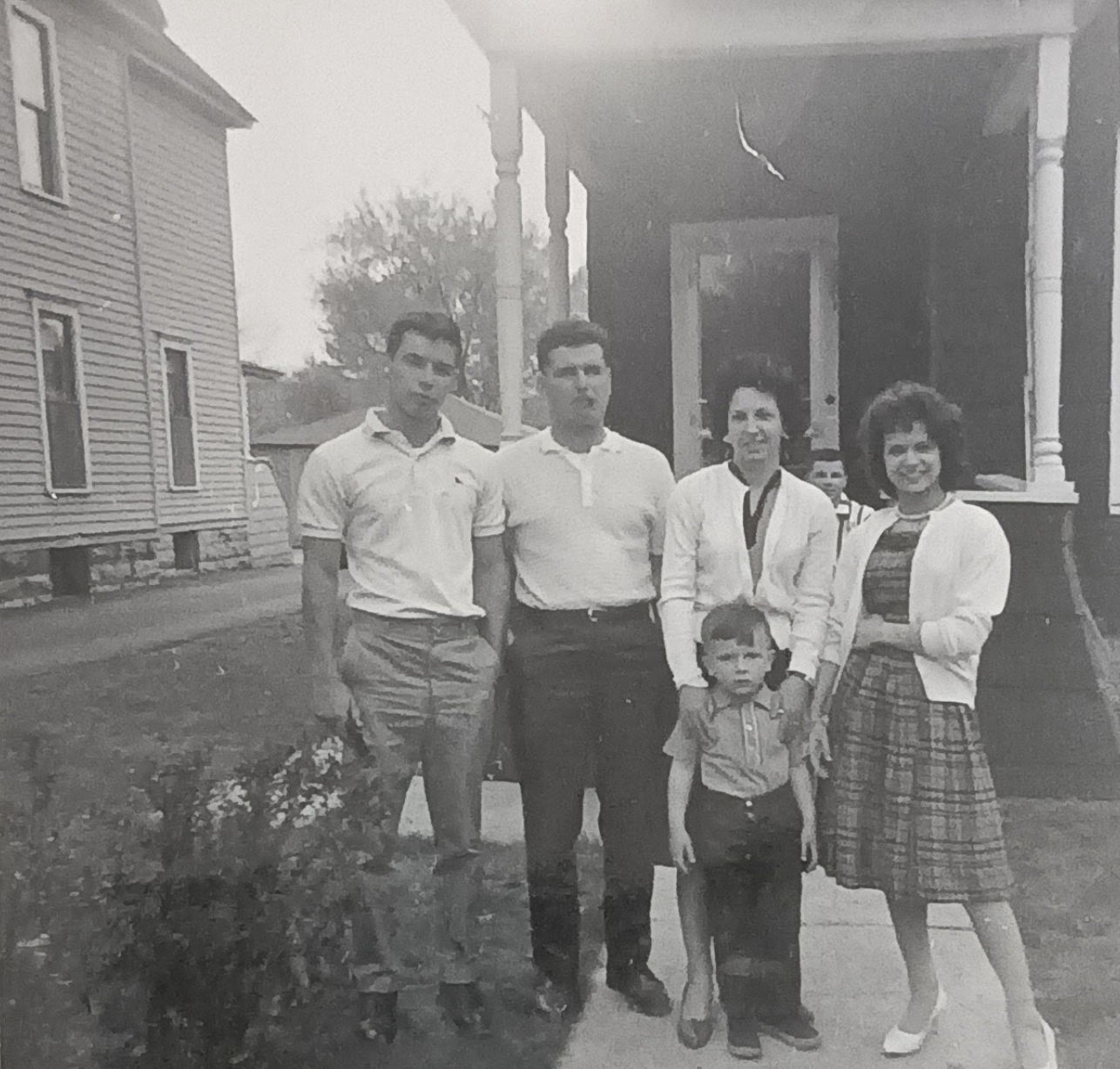
The Maiolo Family, Tim, Leon, Ruth, Leon Jr, Terry
The tragedy of losing Sheila Rose and the varied ages of his children formed the backdrop to Leon’s life as he transitioned into the routines of quarry work. His experiences in France, the time spent away from his young family, and the grief of his daughter’s brief life left a profound impact, shaping his dedication to hard work, family, and the simple, steadfast routines that would define the rest of his days.
The Quarry Life
The quarry became more than a place of employment for Leon—it was the landscape where he built a career, friendships, and a deep sense of purpose. At the General Crushed Stone Company’s quarry located at 25133 State Route 3 in Watertown, New York, Leon became a respected and reliable presence.

General Crushed Stone Company Logo
Each day, he drove from his home on Leray Street, just 3.1 miles away, navigating steep, narrow roads shared with towering dump trucks. The winding descent into the quarry was challenging, lacking guardrails and demanding vigilance, especially during the colder, icy months. The roads were well-worn paths cut into the landscape, often slick with dust and debris, setting the tone for the rugged work that lay ahead.

General Crushed Stone Company
Daily Routine and Responsibilities
Leon’s days at the quarry were defined by a rhythm of physical labor and skilled precision. As a quarry worker, he took on the strenuous task of drilling into solid rock faces. These drilling tasks involved large, heavy-duty equipment that required both strength and skill to operate. Carefully drilled holes in the rock were used to place sticks of dynamite, which, once detonated, would loosen massive slabs of stone for processing. This careful, calculated process of breaking down rock was both science and art—a skill Leon honed over time, ensuring that each blast was controlled to maximize yield while minimizing the risk to equipment and crew.
The detonations would shake the ground, releasing clouds of dust and debris, and leaving large chunks of stone ready for further processing. The rock was then hauled by massive dump trucks up the steep road to the crusher, which was positioned at the top of the quarry. The crusher, the heart of the operation, transformed these large boulders into finely crushed stone, used in various construction projects around the state. The limestone and dolomite particles generated during this crushing process created a white dust that permeated everything and clung to everyone. Leon, working close to these activities, would come home each day covered head to toe in this fine, white powder.
The white dust, a blend of limestone and dolomite particles, was not just a byproduct of the work but became a part of Leon’s daily life. It coated his clothes, seeped into his hair, and settled on his skin, leaving him looking ghostly pale by the end of each shift. His standard work attire—a pair of blue pants and a blue button-up shirt—quickly became his signature look, worn day in and day out. This “uniform” was practical, allowing him to weather the grime and grit of quarry work. And each evening, despite the dust and fatigue, he returned home with a sense of satisfaction, carrying with him the tangible marks of a hard day’s work.
The Black Metal Lunch Pail
Leon’s daily routine was punctuated by a simple but cherished lunchtime ritual. Every day, he brought his black metal lunch pail to work, a classic icon of mid-century labor life. Inside, he packed the same meal: a cold-meat sandwich on white bread and a thermos of Campbell’s soup. This straightforward lunch was both practical and emblematic of Leon’s no-nonsense approach to life. Eating in the quarry’s break room—a metal building with a semi-circular roof that served as a refuge from the dust and noise—Leon found brief respite in the company of his coworkers. These break times, though short, offered moments of camaraderie, where he shared conversations and laughter with friends like Tody and Waldo, forging bonds amid the dusty, rugged setting.
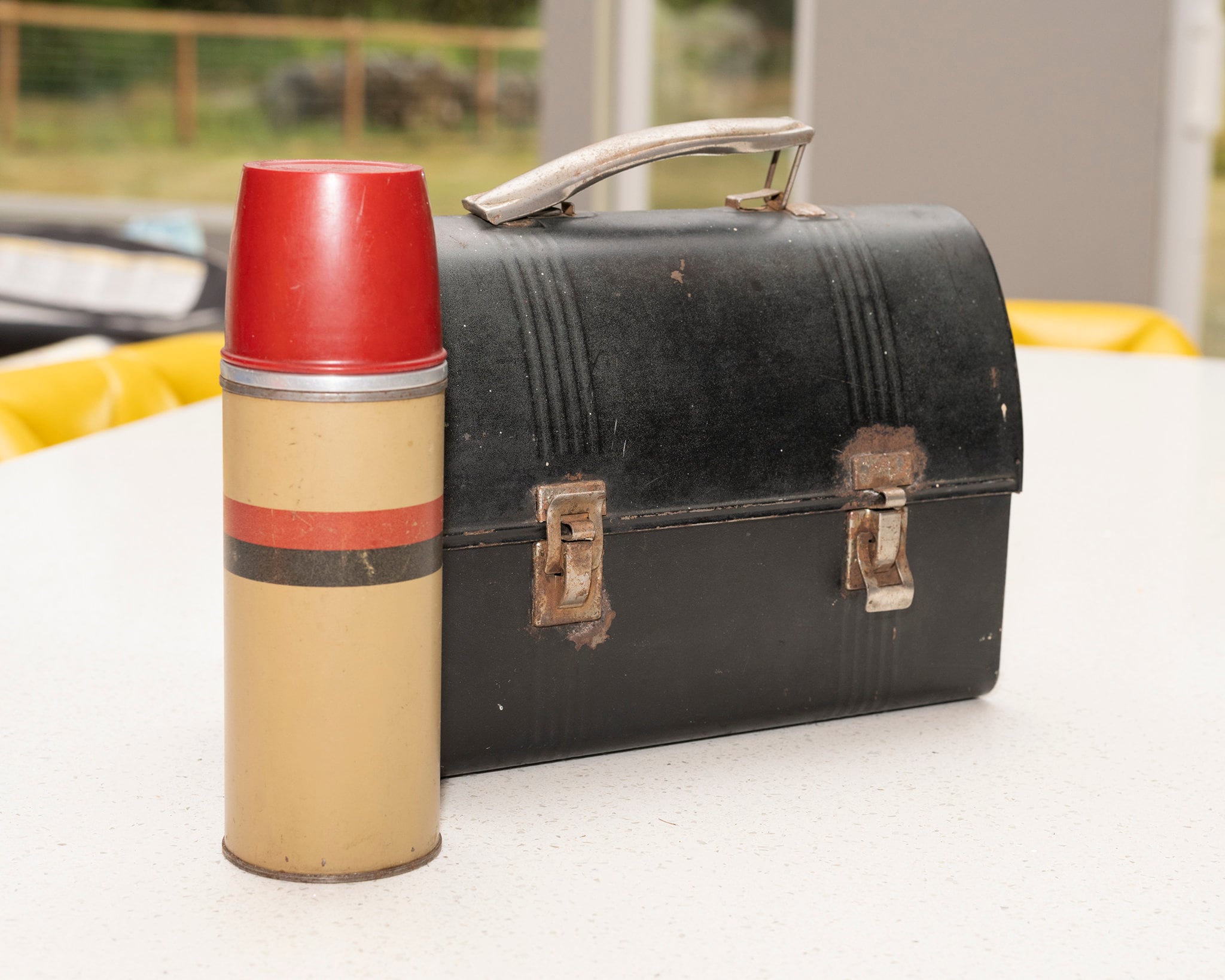
Black Metal Lunch Pail and Thermos Used by Leon
Transition to Welding
In the mid-1960s, the quarry presented Leon with an opportunity to expand his skill set. When the need for a welder arose, he seized the chance to learn the trade, traveling to Ohio for a one- to two-week training course. Welding was a critical skill in an environment where heavy equipment frequently broke down under the intense demands of quarry work. From this point on, Leon became the quarry’s go-to welder, stepping in whenever machinery needed repairs. Welding allowed him to apply a precise, technical skill, reinforcing and repairing essential equipment to keep the operation running smoothly. His role as a welder was invaluable, adding a new dimension to his contributions and marking him as a versatile worker.
The Grind of All-Season Work
Leon’s work at the quarry spanned every season, though the winter months were slower. Most workers would take unemployment during this period, but Leon was one of the few who stayed on full-time year-round. His willingness to work through the winter marked him as a steadfast employee, one who kept the operation going even in the harshest conditions. Winter at the quarry was a unique challenge: the cold made equipment harder to operate, the roads grew slick and dangerous, and the need for stone decreased. Yet Leon continued, showing up each day with the same dedication, navigating the treacherous roads and working alongside a skeleton crew to maintain the quarry’s essential functions.
The Social and Physical Landscape of the Quarry
The quarry itself was a stark, dramatic landscape—a vast pit carved into the earth, lined with cliffs of raw stone and punctuated by the hulking presence of industrial equipment. The pit, now filled with spring water, formed a pond at the bottom, creating a surprising contrast to the industrial surroundings. This spring-fed pond, large enough to be called a city block in size, added a touch of nature’s beauty to the otherwise harsh environment. Stocked with trout by his friend Waldo, the pond became a unique feature, one that Leon’s children enjoyed for fishing and exploring—a reminder that even amid the relentless grind of quarry life, there were pockets of tranquility.

General Crushed Stone Company Satellite View, with Fishpond in Center
Friendships and Shared Hardships
The relationships Leon developed with his coworkers became an integral part of his life at the quarry. His friendships with men like Tody and Waldo were forged through shared experiences, mutual respect, and the occasional laugh over a dusty break room lunch. These were friendships of necessity and choice, built on the bonds of shared labor and common understanding. In a place as physically demanding and mentally taxing as the quarry, these friendships provided vital support. Whether exchanging tips on how to handle tricky equipment or sharing stories about family life, Leon and his friends found solace in each other’s company.
The Legacy of Quarry Life
Over the years, the General Crushed Stone Company became more than just a workplace for Leon—it was a defining part of his identity. The quarry was a place of hard labor, personal growth, and camaraderie, where Leon’s strength, resilience, and skills were constantly put to the test. Through his years of drilling, blasting, and welding, he became known for his reliability, his practical skills, and his quiet determination. As his son and grandchildren would come to learn, Leon’s life at the quarry was a testament to the values of hard work, loyalty, and perseverance, etched into every stone he helped to break, every machine he repaired, and every friendship he built amid the dust and noise.
Service in the Army Reserve (1950-1965)
In 1950, five years after returning home from World War II, Leon joined the Army Reserve in Watertown, NY. He was 29 years old at the time and had already begun to establish a steady life for himself, working full-time at the General Crushed Stone Company and raising a young family. Over the next 15 years, he would balance his roles as a quarry worker, husband, father, and sergeant in the Army Reserve, bringing discipline, resilience, and a strong sense of duty to each area of his life.
By 1950, Leon and his wife Ruth were already parents to two children, Tim (born 1942) and Terry (born 1946), and would welcome their third child, Leon Jr., in 1959. Leon’s time in the Reserve overlapped with the births and early childhoods of his children, and his dedication to the Reserve added another layer of responsibility to his already busy life. Joining the Army Reserve was a way for Leon to continue serving his country, an extension of the values he had carried home from the war. His role as a sergeant required regular training, drills, and occasional weekend commitments, which meant he often had to carefully juggle his Reserve duties with his family and work obligations.
Life at the quarry was demanding, but Leon’s commitment to the Reserve introduced a structure and discipline that helped him manage the challenges. His experience in the military—both during active combat in France and later as a Reserve sergeant—taught him resilience, leadership, and time management. These skills carried over into his work at the quarry, where he was known for his reliability and endurance. Weekdays at the quarry were filled with heavy labor, often leaving him covered in stone dust, but on weekends, he would don his military uniform, transforming from quarry worker to Army sergeant.
Leon’s role in the Army Reserve was one of leadership. As a sergeant, he trained younger recruits, sharing with them his firsthand combat experience and instilling in them a sense of duty and preparedness. He was likely responsible for teaching various military skills, from basic drills to leadership principles, helping to prepare his unit for any potential deployment. This position not only reinforced the values he had gained during his time in the war but also allowed him to give back to the military community, sharing his knowledge with the next generation of soldiers.
For his family, Leon’s commitment to the Reserve was a source of quiet pride. The Reserve brought an element of military life into the home, subtly influencing the family’s values and routine. His children grew up with the understanding that their father was both a civilian worker and a soldier, someone who had fought in a war and continued to serve even in peacetime. Leon’s discipline and sense of duty became a model for his sons, who observed their father’s ability to balance his multiple responsibilities with quiet determination.
Leon’s service in the Army Reserve concluded in 1965, when he was 44 years old. By that time, he had completed 15 years of Reserve duty, all while raising a family and building a reputation as a dependable worker at the quarry. This dual commitment to both his family and his country defined much of his adult life, reinforcing the values of resilience, hard work, and loyalty. His Reserve years added a unique dimension to his legacy, leaving a lasting impression on his family, who respected not only his dedication to his job but also his steadfast commitment to his country.
Traditions and Evenings at Home
Leon’s home life after a day at the quarry was a comfortable blend of routines and cherished traditions. After arriving home, often in a car covered in white quarry dust, he would join Ruth and their family for a hearty dinner. Ruth prepared each meal with care, always beginning with a tossed salad topped with Italian dressing. The salad was a staple in the household, a constant at the table that Leon enjoyed so much he jokingly called the leftovers “dessert” if there was any remaining.
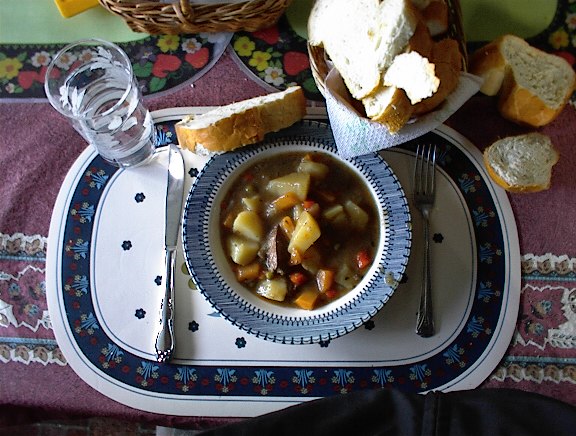
A dinner cooked by Ruth Maiolo
Dinner itself reflected the simple, filling meals of the time: hamburgers, spaghetti, tough cuts of steak, liver, and the unique family dish of creamed peas on toast. These familiar foods not only nourished but also added a sense of consistency and comfort to each evening, a fitting end to Leon’s physically demanding workdays.
Evening Entertainment and Family Dynamics
After dinner, Leon settled into the living room, where he immersed himself in his favorite westerns and war movies.
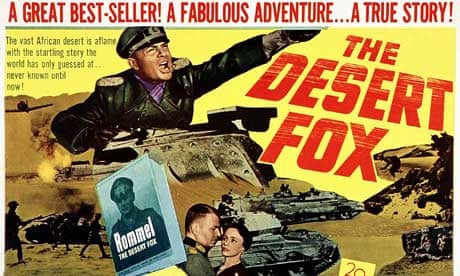
Westerns resonated with him, echoing the rugged landscapes and resilient characters he admired. But his true favorites were the war films, especially those about World War II, which brought him back to the experiences of his own service in France from 1943 to 1945. He had a special fondness for films like The Desert Fox, which depicted the story of Rommel, the German tank commander, and Patton, which highlighted the strategies and boldness of General Patton. Pork Chop Hill and Battle of the Bulge were also on his list, offering portrayals of military life and battles that echoed his own memories.
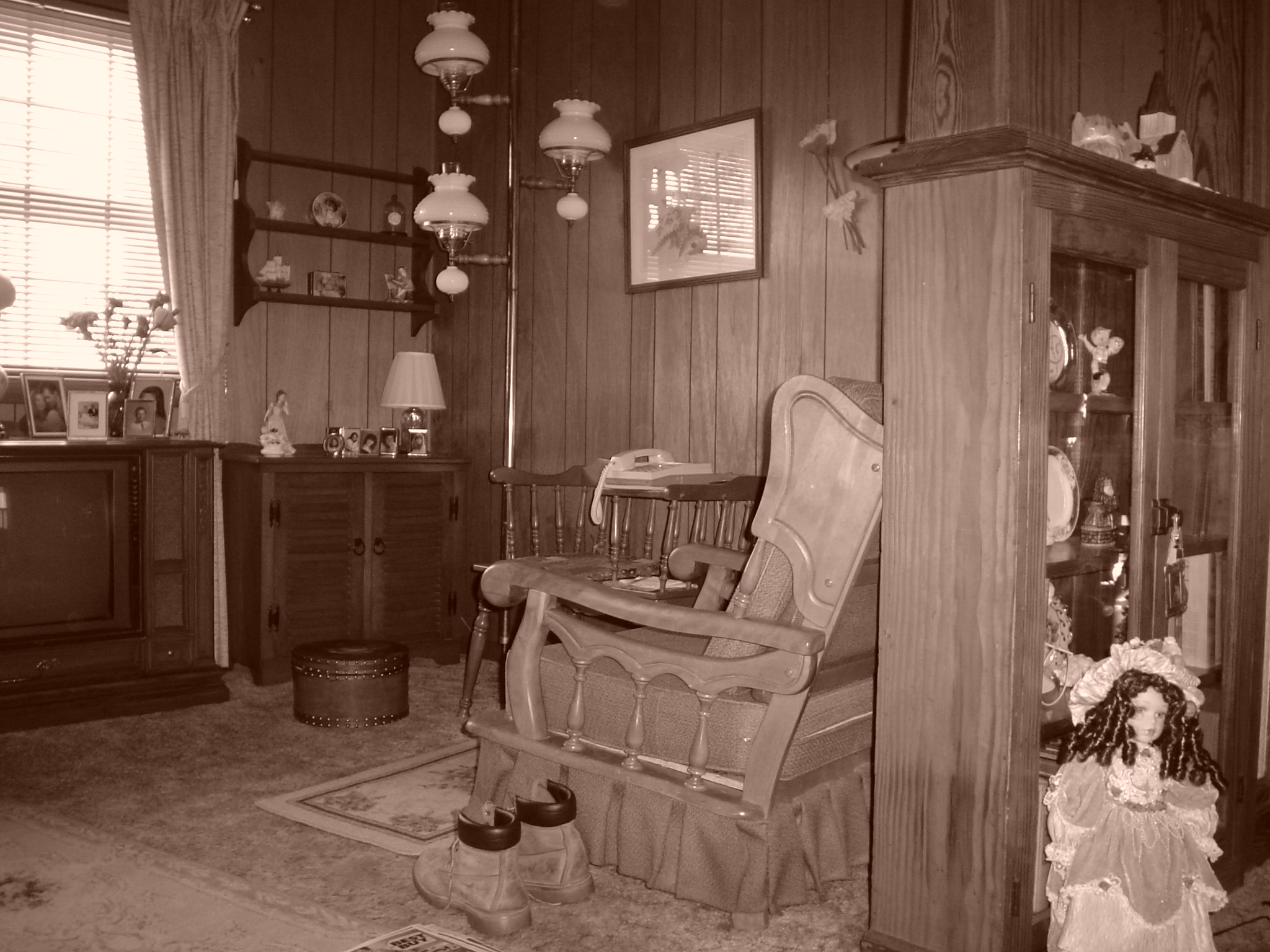
The Chair Leon Sat in and Watched Movies
While Leon was absorbed in these films in the living room, Ruth found her own retreat in the adjacent bedroom, reading books that brought her a sense of calm. This separation allowed each of them to unwind in their own way, yet they were always close by, sharing the comfort of home in their own unique rhythms.
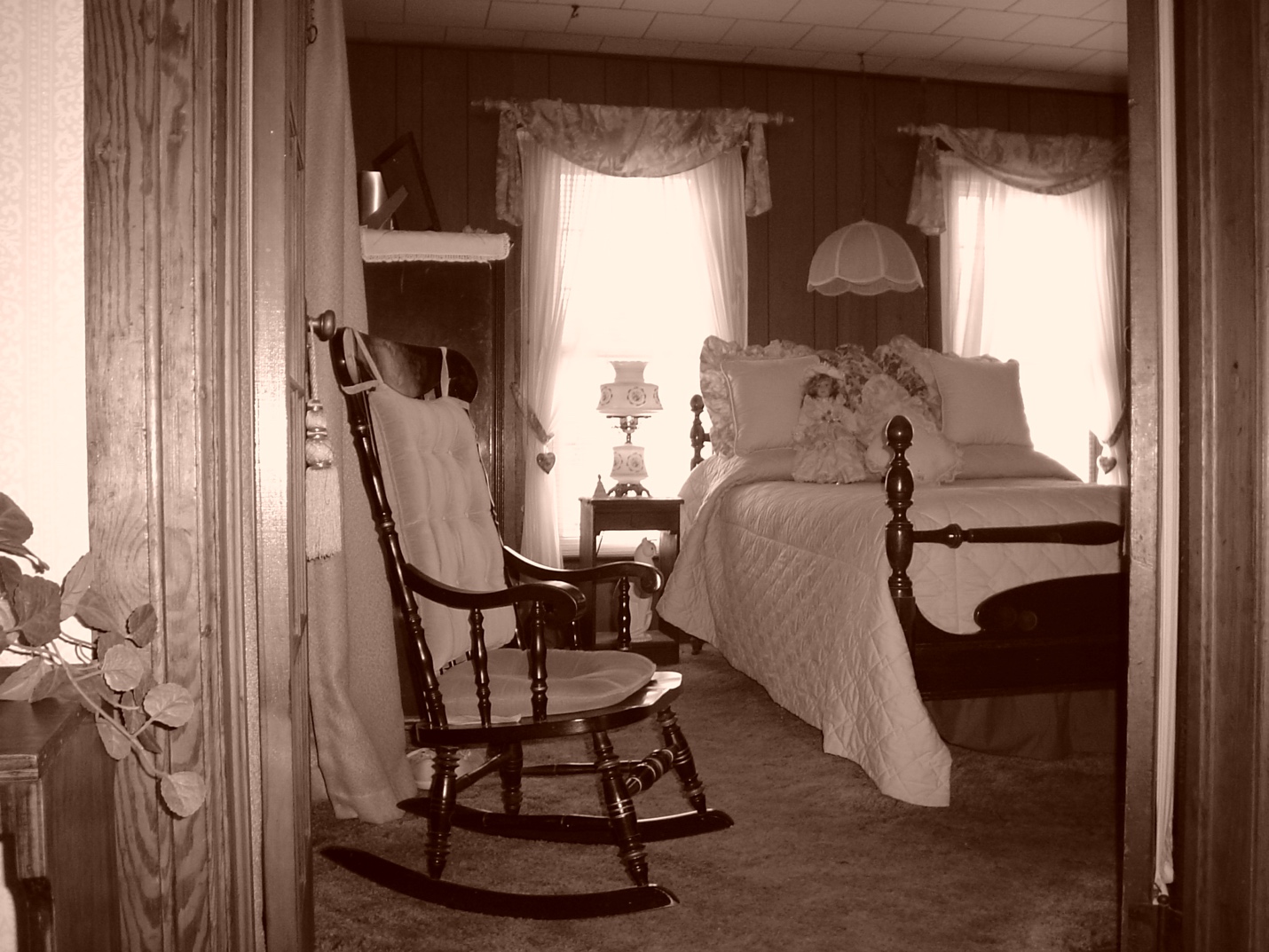
The Chair in the Bedroom Ruth Read Novels
Summer Evenings on the Front Porch
In the warm evenings of summer, after a hearty family dinner and the steady voice of Walter Cronkite on the CBS News, Leon and Ruth embraced a cherished ritual. They would settle into their folding aluminum chairs on the front porch of their home at 852 Leray Street, enjoying the calm of twilight as the neighborhood slowly came alive. This quiet porch, with its simple setup of aluminum chairs, became a gathering place as neighbors and friends noticed Leon and Ruth’s presence and drifted over to join them.
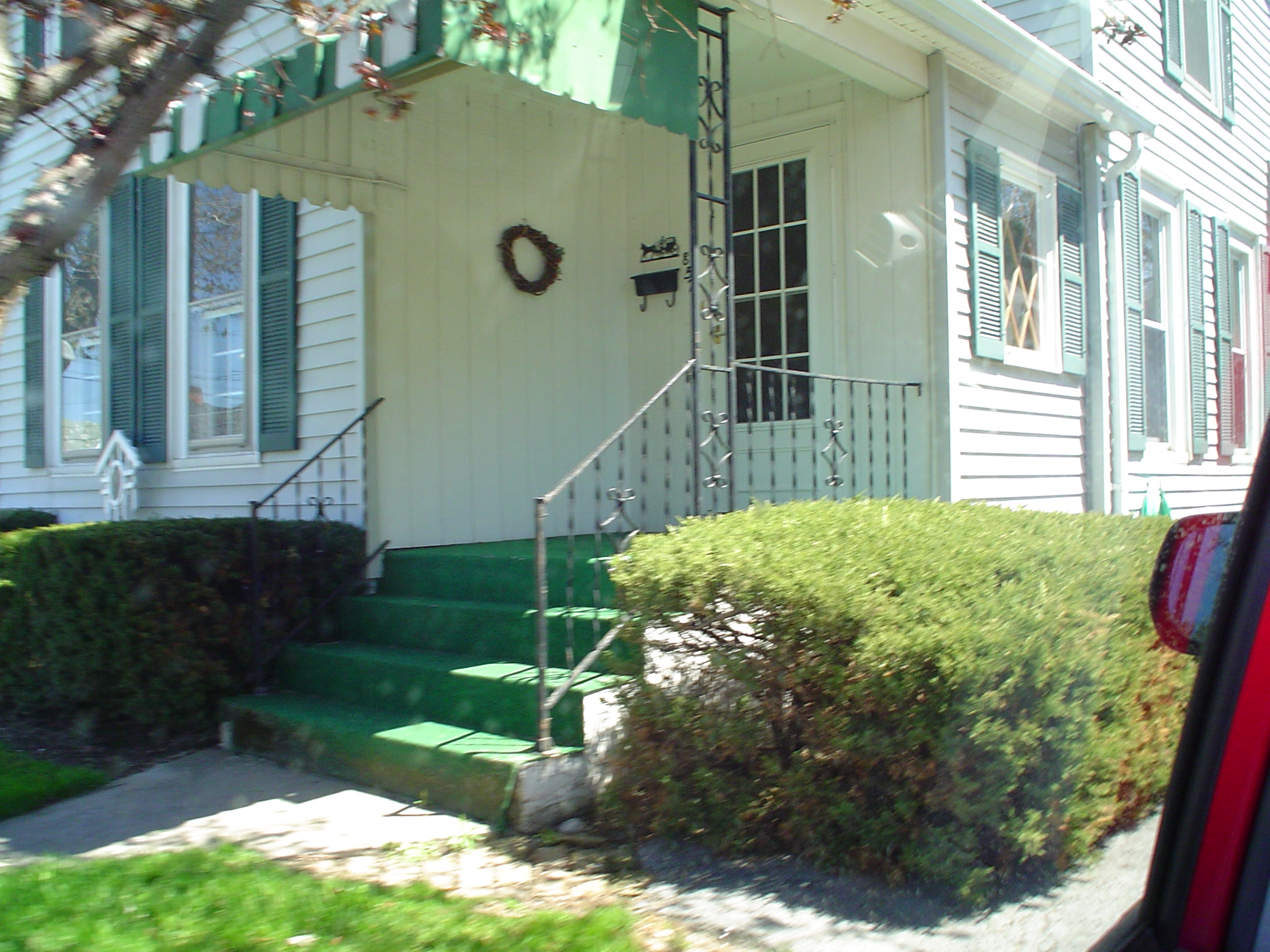
The Front Porch on Leray Street
One by one, familiar faces appeared, often bringing along stories, laughter, and discussions of the day’s news. Among the regulars were Wayne BeeBee, Bobby Bisnet and his daughter Kate Minkler, and several of Tim’s friends, including Roy Remsey and Robert Douglas. With 8 or 9 people gathered on the porch and steps, the group would settle into easy conversation, usually centered on the day’s events and major topics in the news.
The Vietnam War, unfolding across the world, was a frequent topic, capturing the attention of young and old alike. One evening, Robert Douglas, who was around Tim’s age, announced that he would be heading back for a second tour in Vietnam. His announcement surprised the group, and adults questioned his decision, asking, “You’re going to serve another tour in Vietnam? Isn’t that dangerous?” His response reflected his fearless perspective on life: “You could die anywhere, such as getting hit by a car.” Ironically, years later, after completing his second tour and opening a small car repair shop, Douglas tragically died while welding a gas tank, a stark reminder of the unpredictability of life that he had spoken of that evening.
A Sense of Community and Connection
These evenings on the porch were more than just neighborhood gatherings; they represented a sense of community and connection. The conversations, the shared thoughts on world events, and the presence of close friends provided Leon and Ruth with a feeling of companionship beyond the walls of their home. Through each summer, as familiar faces gathered on the porch, these evenings became a cherished part of their lives—a blend of routine, friendship, and engagement with the world beyond.
Poker Nights at the North Side Improvement League
One of Leon’s favorite pastimes was his weekly poker game at the North Side Improvement League, a gathering spot on North Street. As a League member, he was committed to the organization’s mission of improving the north side of Watertown, where he lived on Leray Street. The League provided a place for North Siders to come together, support their neighborhood, and enjoy some recreational time. For Leon, poker night was a chance to relax, connect with friends, and test his luck and skill in a game that required patience, strategy, and a bit of nerve.

North Side Improvement League
Leon came prepared, bringing a peanut butter jar filled with quarters, dimes, and half dollars to use as his poker stakes. This jar of change became his signature, a practical and no-nonsense way to bring his money for the game. Leon’s weekly trips to the League were part of his routine, a steady commitment that blended social interaction with friendly competition. The game brought together men from the community who, like Leon, found a sense of camaraderie in this familiar setting.
The North Side versus the South Side
The Improvement League wasn’t just a social club; it reflected a strong sense of local pride. The north side of Watertown, known for its working-class roots, was a community of people like Leon who valued hard work and resilience. North Siders, however, often saw the South Siders as more affluent and privileged, while South Siders viewed the North Side as rougher around the edges and even a bit dangerous. The truth wasn’t far off: the north side had its share of challenges, with a reputation for being a tougher, less polished area.
Leon was aware of these perceptions and would occasionally mention the divide, noting how North Siders and South Siders viewed each other through this lens of privilege versus grit. The Improvement League served as a community anchor, allowing North Siders to come together, celebrate their neighborhood, and support its growth and improvement. Poker night was one of many ways the League fostered community spirit, giving Leon and his fellow members a chance to connect, share stories, and build bonds over a game they all enjoyed.
A Quiet Tradition of Resilience
Leon’s poker nights became another part of his life that balanced hard work with personal enjoyment. The League, with its mission to support the north side and its reputation as a neighborhood stronghold, embodied the same principles that guided Leon’s life: loyalty, resilience, and community. Through his time spent at the poker table with friends, Leon was both contributing to and drawing strength from his neighborhood. Poker night wasn’t just a game; it was a small tradition that allowed him to relax, reconnect, and continue his quiet support for the place he called home.
Bowling League at Watertown Bowl
Leon’s winter evenings included a regular commitment to his bowling league at Watertown Bowl, located on Outer Washington Street in Watertown. A skilled and focused left-handed bowler, Leon took pride in his technique, competing with precision and earning himself a reputation as one of the league’s top players. His dedication paid off when he earned trophies for achieving the league’s high triple score, a testament to his consistency and skill. That same season, his team won the league championship, adding another trophy to his growing collection.

Watertown Bowl
Sometimes, Leon brought his young son, Leon Jr., to the alley. For Leon Jr., these evenings were an adventure. Along with other children whose fathers were also in the league, Leon Jr. would roam the bowling alley, making friends and playing games like hide-and-seek. The children turned the alley’s dimly lit corners and benches into makeshift playgrounds, while their fathers focused on the lanes. Though Leon didn’t speak much with his son during these outings, he enjoyed sharing this part of his life with him, giving Leon Jr. a chance to witness his father’s skill and passion for the game.
Leon owned his own black bowling ball, a practical choice reflecting his no-nonsense approach to his hobbies. With a dedicated 8-week season, bowling became another cherished part of his winter routine, a time for competition, camaraderie, and a little escape from the daily grind.
Woodworking Craftsmanship
From the 1950s through the 1980s, Leon developed a strong passion and skill for woodworking, which he pursued in his garage and basement workshop. Working mostly with pine—a wood known for its durability and workability—Leon approached his projects with precision and a craftsman’s eye for detail. His woodworking skills grew through years of practice, and over time, he mastered the tools and techniques necessary to create functional, beautifully crafted pieces. Each project became a labor of love, reflecting his meticulous nature and the pride he took in building with his own hands.
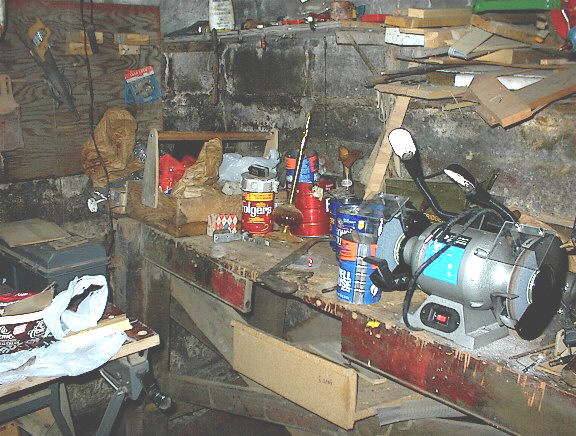
Leon’s Basement Workshop
Leon’s projects often began with a rough concept or a picture, which he would translate into a full pattern, cutting templates himself to guide each cut and joint. He relied heavily on his jig saw for intricate cuts and curves, a tool well-suited for handling the precise shapes he needed for cabinet doors and decorative elements. For straight cuts and larger pieces, he turned to his circular saw. With these two primary tools, Leon could tackle almost any project, whether it required precision cutting or broad strokes.
One of his signature projects was a pair of corner cabinets for the family’s dining room. He designed these from scratch, creating a balanced and elegant piece that fit snugly into the room’s corners. The cabinets featured glass-panel doors on the top half, which he fitted himself, adding a touch of sophistication to the room. Below the glass doors, solid wood doors enclosed a bottom cabinet, providing additional storage. A shelf in the middle of the cabinet allowed for practical display space, balancing beauty with functionality. Leon cut each panel, attached the hinges, fitted the cabinet hardware, and carefully sanded and stained the wood until it had the rich, warm glow that became his hallmark.
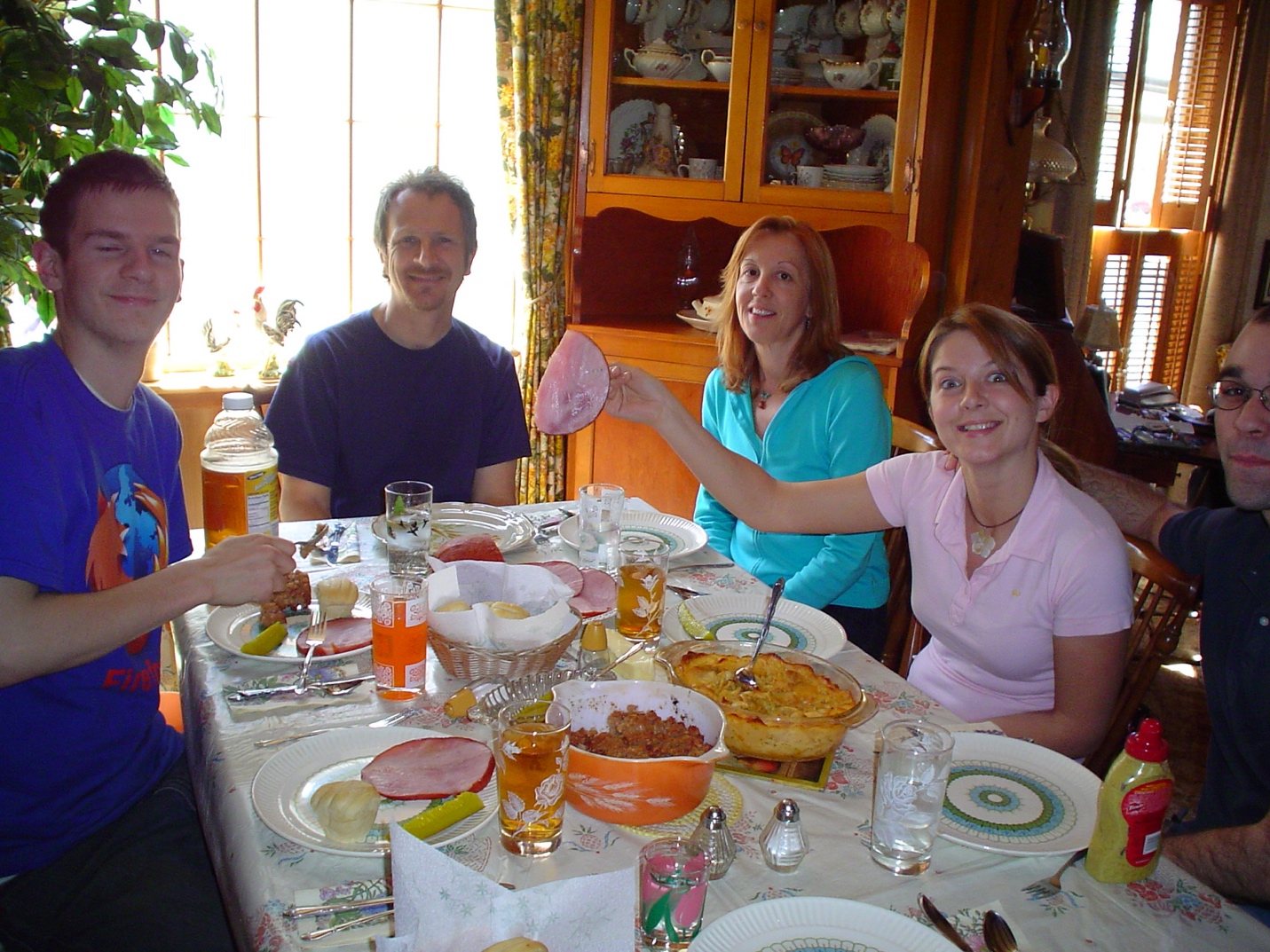
Hutch in Corner, Built by Leon
Leon’s skill extended beyond the family home. At their retirement cottage, he took on the ambitious task of building all the kitchen cabinets from scratch. He created a rustic yet refined hutch that became a centerpiece in the cottage’s dining area. This hutch, along with the kitchen cabinets, remains a cherished piece of family history, currently in the dining room of his son, Leon Jr. It serves as both a functional item and a lasting symbol of Leon’s craftsmanship.
One of Leon’s more impressive feats was recreating a cabinet from a single picture in an Ethan Allen magazine. Ruth had admired a particular piece, pointing it out to Leon, and he set out to make his own version. Without measurements or detailed schematics, Leon carefully analyzed the picture, designed his own pattern, and crafted a cabinet that closely matched the original. His ability to reverse-engineer the design from a mere image spoke to his intuitive understanding of woodworking techniques, proportions, and materials.
In addition to his work with wood, Leon was skilled in other areas of construction. He single-handedly built the back porch of their home, including the roof framing and rafters, and poured the cement for the porch floor himself. This back porch became an important gathering spot, a testament to his dedication and capability as a builder. At the cottage, Leon also poured the concrete for a set of cement stairs that led down to the water. These stairs were no small feat, requiring careful planning and precise execution to ensure they were both safe and long-lasting.
Leon typically worked alone, finding a sense of peace in the solitary nature of his craft. Occasionally, Leon Jr. would lend a hand, passing tools or observing his father’s technique. However, Leon preferred to rely on his own skills, patiently cutting, fitting, and finishing each piece until it met his high standards. Working on weekends, he poured hours into his projects, using his woodworking time as a way to unwind from the rigors of his daily life at the quarry.
Leon’s pieces weren’t just furniture; they were handcrafted works of art that carried the family’s legacy through the generations. Each corner cabinet, kitchen hutch, and porch represented his skill, dedication, and pride in workmanship, creating lasting pieces that would continue to be used and admired by his family long after he was gone. His woodworking, much like his character, was practical yet quietly remarkable, built to endure and to serve.
Shared Adventures with Leon Jr.
Though Leon was a man of few words, he found meaningful ways to bond with Leon Jr. through simple activities that brought them closer. These outings gave Leon Jr. memorable experiences and allowed Leon to share small traditions and teach his son the joy of simple pleasures.
- Milkshakes at Calendar’s Drug Store: One of their favorite stops was Calendar’s Drug Store, where the soda fountain was the main attraction. The drugstore’s classic counter, with its stainless steel milkshake machine, swivel stools, and bar setup, felt like stepping back in time. Leon would treat his son to milkshakes or sundaes, watching as the stainless steel cups, once mixed, were poured into tall glass cups and served with a straw. Together, they would sit at the counter, savoring the creamy milkshakes in comfortable silence. These outings were a small luxury and a quiet bonding experience.
- Fishing Trips: Fishing was another shared tradition. For trout fishing, Leon would take Leon Jr. to a favorite spot with Waldo, his close friend and a fellow fishing enthusiast. Together, the three would spend hours by the water, teaching Leon Jr. patience and the quiet thrill of waiting for a bite. Leon also took him bass fishing, often joining another friend, Tody, who owned a small 16-foot boat docked in Sackets Harbor. With a steering wheel and just enough room for them to fish comfortably, Tody’s boat offered a modest but memorable fishing experience on the open water.
- Ice Fishing in Sackets Bay: When winter set in, Leon and Leon Jr. would go ice fishing with Waldo in Sackets Bay. This activity required drilling through thick ice, and Leon Jr. was fascinated by the process. Ice fishing was another example of the patience and perseverance Leon valued, and it was a favorite memory for Leon Jr., who admired the skill and care his father took in such cold conditions.
Through these outings, Leon found small but meaningful ways to pass on life’s lessons to his son. These shared activities became a unique part of Leon’s legacy, capturing the quiet yet significant bond between father and son.
The Children’s Lives and Routines
The family’s routines extended to their children, each of whom had a distinct role and activity in the household.
Tim’s Pool Hall Talent
Tim, Leon’s eldest son, had a natural talent for pool that quickly earned him a reputation around Watertown. During his high school years, he became known as a “pool shark,” consistently winning games and often playing for money. His preferred place was a hidden pool hall located at the back of Roy Lawton’s Barber Shop. To get there, you had to pass through a curtain that led to a dimly lit room with six pool tables, each illuminated by a solitary overhead light. This room had an atmosphere of quiet intensity, where Tim honed his skill, moving around the tables with precision and confidence.
Tim’s skill quickly became the talk of the town among his peers, and soon, he had a steady following. People would place small bets, confident in Tim’s ability to win. For him, pool was more than just a game—it was a way to earn extra money and enjoy a bit of independence. These games turned into a social event, drawing in friends and classmates who respected his talent and admired his success. Playing pool became Tim’s unique mark, a pastime where he stood out and brought a sense of excitement and reputation.
Parking Tickets and a Rebel’s Streak
Tim’s trips to the pool hall, however, had a few side effects. Often, he would drive one of his parents’ cars—a green 1954 Ford Crestline before Leon bought the Studebaker—and park it wherever he could find a spot near Roy Lawton’s. Unconcerned with meters or parking restrictions, Tim had a habit of parking right in front of a meter without paying. Over time, this casual disregard for parking regulations earned him a considerable collection of tickets.
For a while, the growing stack of tickets went unnoticed by Leon and Ruth, who were likely unaware of just how many fines had accumulated. But one day, the extent of Tim’s parking “strategy” came to light in a memorable way. Ruth, while in the car, reached up to adjust the sun visor, only to be showered with a cascade of parking tickets—about 20 in total. It was a moment of both surprise and exasperation, with Leon and Ruth realizing the extent of Tim’s disregard for parking rules. For Tim, the tickets were just a small price to pay for his time spent at the pool hall.
A Unique Chapter in Family Life
Tim’s pool hall adventures and the parking tickets became part of the family’s stories, remembered as examples of his independence and bold character. The pool hall, with its smoky atmosphere, dim lights, and whispered bets, was a world where Tim thrived, a place where he was known for his skill and confidence. The tickets were a humorous footnote, a reminder of Tim’s spirited personality and his determination to carve out his own path, even if it came with a few fines along the way.
In the context of Leon and Ruth’s structured, hardworking lifestyle, Tim’s pool hall escapades and his relaxed attitude toward rules added a different layer to the family dynamic. It was a contrast that enriched their family story, reflecting the diversity of personalities and experiences within their close-knit household.
Terry’s Job at the Movie Theater: Terry, Leon’s daughter, took on a part-time role as a ticket-taker at the local movie theater, the Town movie theater. Standing at the theater entrance, Terry greeted patrons and took their tickets, adding a social aspect to her evenings and a way to contribute to the community. This job was her own steady role, reflecting the family’s inclination toward consistent work and reliability.
Leon Jr.’s Solo Playtime: Leon Jr., the youngest, had a childhood marked by solo play, as his older siblings were already well into their teenage years. With Tim and Terry busy with work and school, Leon Jr. often entertained himself with his army men and Matchbox cars, creating intricate scenarios on his own. The nearby war movies his father watched added inspiration to his play, giving him stories and themes to reenact as he built his own imaginary battles.
The Family’s Cars and Daily Life
Leon’s cars were integral to his daily life and the family’s experiences, each vehicle marking a chapter in their journey together. His first notable car was a green 1954 Ford Crestline, a sturdy, classic model that carried him to the quarry day after day. The Crestline was a symbol of Leon’s commitment to his work, its reliable build suiting the demands of his commute on the steep, unguarded roads to the quarry site. Practical and resilient, it set a standard for the cars that followed, reflecting Leon’s steady, unpretentious approach to life.

Dark Green 1954 Ford Crestline, same as Leon’s
Following the Ford Crestline, Leon acquired a black mid-60s Studebaker. This car was just as practical, with a touch of distinctive style. It accompanied him through the demanding years of rock crushing and early welding work, navigating the dusty roads leading in and out of the quarry with ease. For Leon, the Studebaker represented another step in his role as a provider, a continuation of his commitment to the daily routine that defined his life. The Studebaker also carried memories of family errands and Sunday drives, linking Leon’s working life with family moments on the road.

1964 Black Studebaker
In the late 1960s, Leon replaced the Studebaker with a light blue Chevy Chevette. Smaller and more economical, the Chevette suited the needs of the family and Leon’s work commute, but it was the car that followed—the maroon 1969 Chevy Malibu—that would become an unforgettable piece of the family’s history.
The 1969 Chevy Malibu became Leon’s primary vehicle, symbolizing stability and longevity. The Malibu, with its bold maroon color and reliable build, was a family favorite. Leon’s dedication to his work and home life was embodied in this car; it took him to the quarry daily, hauled supplies, and carried the family on outings. Over the years, however, it sustained its share of wear and tear. On one occasion, Leon accidentally dented the left front fender by driving it into a pole. His wife Ruth was none too pleased, and the dent became a point of mild irritation and family lore, an imperfection that symbolized the car’s life of service and its many trips.
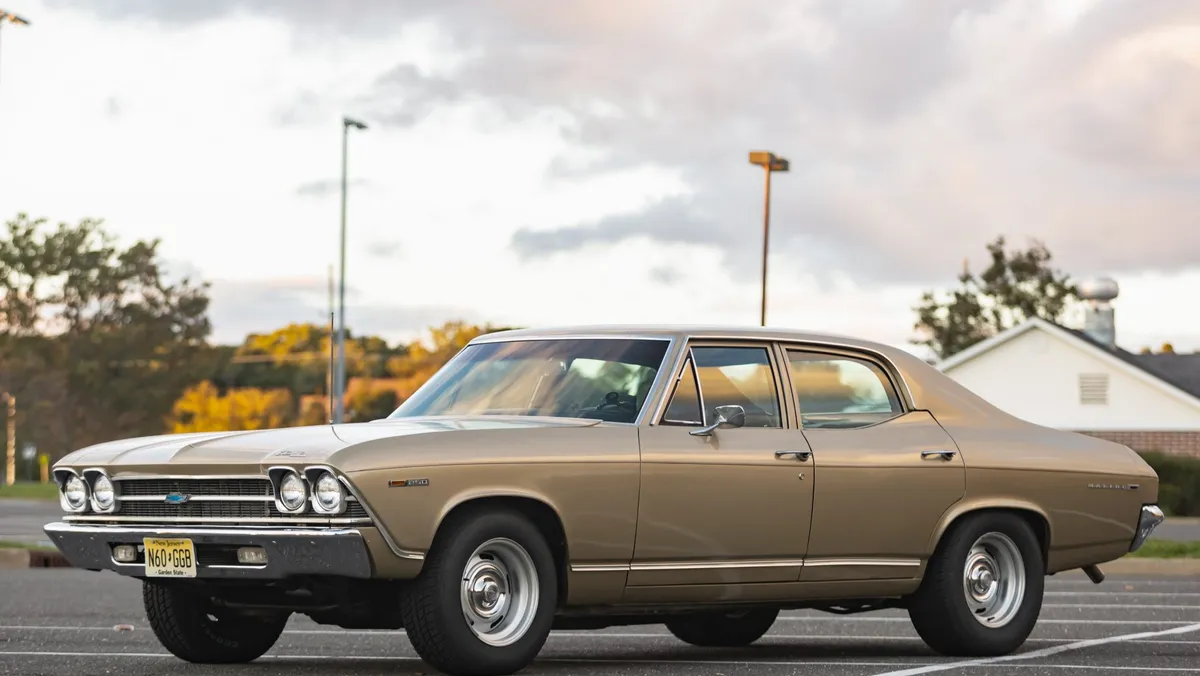
1969 Chevy Malibu
The Accident in 1980
In March 1980, the Malibu was involved in a serious accident that would leave a lasting impact on the family. While Leon was not driving, Ruth and their daughter-in-law, Pam, who was pregnant with Leon’s grandchild, Amberly Maiolo, were in the car when a drunk driver hit the Malibu from behind at full speed. The collision devastated the back of the car, crushing the trunk area entirely. This violent impact ended the Malibu’s time with the family, as the damage was beyond repair.
For Ruth, the accident left long-term physical effects. She began experiencing chronic back pain as a result, which would persist in the years that followed. The incident underscored the risks that came with even routine drives, a sobering reminder of life’s unpredictability. The drunk driver was arrested for driving under the influence, but the damage to both the family’s car and Ruth’s health was irreversible. The incident was a somber moment in the family’s history, marking an abrupt end to the Malibu’s years of service and leaving a lasting impact on Ruth.
The Cars as Symbols of Family Legacy
Leon’s series of cars, from the green Crestline to the beloved Malibu, became a tapestry of family memories, workdays, and routines. Each vehicle carried with it not only Leon’s dedication to his family and his job but also moments of joy, minor frustrations, and life-altering events. The dented fender of the Malibu, the cascade of parking tickets from Tim hidden in the sun visor, and the fateful crash in 1980 were all reminders of the family’s journey together.
These cars reflected Leon’s steady presence, his commitment to hard work, and his resilience in the face of life’s challenges. Though simple and practical, they became woven into the family’s stories, each vehicle adding its own chapter to the legacy of a life grounded in hard work, love, and tradition. The cars were more than transportation; they were symbols of Leon’s life, carrying with them the family’s shared history of work, play, and resilience through all the years.
A Rhythm of Tradition and Togetherness
Leon’s home was a place where each family member’s routine contributed to a shared sense of stability. The blend of dinner traditions, movie nights, and individual pursuits created a household marked by both individuality and connection. While they each had their own interests, the routines they built together fostered a sense of warmth and continuity. In this way, their home was more than just a place to live—it was a reflection of the values and resilience that Leon carried from the quarry into the heart of his family life.
Fall Escapes: Fishing and Hunting
For Leon, the crisp air and changing colors of fall marked the start of one of his favorite times of the year. While the rest of the year was defined by steady work routines at the quarry and evenings with family, fall offered him a brief but meaningful escape from daily life. Fishing and hunting provided Leon with not only recreational enjoyment but also a way to connect with nature, renew bonds with friends, and carve out some personal time away from home. These seasonal traditions became cherished escapes that allowed him to balance the demands of his hard-working lifestyle with a quiet pursuit of freedom.
Fishing with Friends
As discussed earlier, fishing was a staple activity for Leon, and he kept this tradition alive through various outings with his close friends, Tody and Waldo. These fishing trips were more than just attempts to catch fish; they were a time for camaraderie, storytelling, and shared silences. Leon would go trout fishing with Waldo, often choosing peaceful spots where they could cast their lines into the cool, flowing water, enjoying the calm as they waited for a bite. Trout fishing required patience and skill, qualities that Leon had in abundance, and these trips with Waldo provided a serene break from the intensity of quarry life.
Leon’s fishing excursions with Tody were a different adventure. Tody owned a modest 16-foot boat docked in Sackets Harbor, complete with a steering wheel that allowed them to navigate easily. The boat wasn’t extravagant, but it served their purpose perfectly, giving them a quiet space to spend hours bass fishing on the open water. For Leon, the time spent in the boat with Tody was both relaxing and invigorating, as the thrill of a tug on the line broke the peaceful surface of the water and reminded him of nature’s unpredictability.
Ice Fishing in Sackets Bay
As winter approached, Leon transitioned from open-water fishing to ice fishing, another passion he shared with Waldo. Ice fishing required a different set of tools and skills, involving drilling a hole in the thick ice that formed over Sackets Bay. The process was physically demanding, but for Leon, it was a challenge worth tackling. With Waldo by his side, he would set up their gear, drill through the ice, and prepare their lines, often standing quietly in the crisp, cold air while waiting for a catch.

Ice Fishing on Sackets Bay
Ice fishing required patience and resilience against the elements, qualities that Leon possessed in spades. For Leon Jr., who sometimes joined, these winter fishing trips were formative memories. The sight of his father working methodically on the ice, undeterred by the cold, left a lasting impression and deepened Leon Jr.’s respect for his father’s skill and determination. These trips weren’t just about catching fish; they were about a father showing his son the beauty of quiet endurance and the reward of persistence.
Solitary Hunts and Family Tradition
Hunting was a cherished part of Leon’s fall escapes, a tradition that connected him to nature and provided a sense of peace and self-reliance. Primarily hunting white-tailed deer, Leon found satisfaction in tracking game through the dense forests, a quiet contrast to the noisy, dust-filled days at the quarry. As a younger man, he also enjoyed small-game and duck hunting, but deer hunting became his focus in later years. He would gut the deer in the woods, then hang them in the family garage, where he skinned and butchered them into various cuts: steaks, hamburgers, and roasts, which he would freeze and enjoy throughout the winter.
While Leon enjoyed hunting alone in his retirement, often at Camp Drum, his earlier hunting years were shared with his brother-in-law Bill Grey. Together, Leon and Bill spent countless autumns navigating the Adirondacks, especially at Bill’s rustic hunting camp on Cranberry Lake. This small shack, fitted with a wood stove, sat right on the lake, offering a tranquil escape. The area around the camp was full of natural beauty, with a stream nearby, a small sandy beach, and a pathway through the woods leading to the lake itself. The camp was set back on a dirt road, surrounded by other hunting camps, creating a close-knit community of hunters.

Camp Drum Hunting Area
During the summer, outside of hunting season, Cranberry Lake sometimes included Leon’s family for day visits. Ruth, along with Leon Jr., would join for the ride, taking in the quiet beauty of the Adirondacks while Leon and Bill prepared for the hunt. For Leon Jr., these trips were an adventure; he got to play with his cousins who were around the same age, exploring the woods, swimming and enjoying the simple pleasures of the camp setting.
After Bill’s passing in the 1970s, Leon’s hunting trips became more solitary. With the absence of his longtime hunting companion, he embraced the isolation, finding a different kind of fulfillment in hunting alone. The solo outings allowed him to reflect and immerse himself fully in the natural world, recharging in the solitude that only the forest could provide. The familiar woods, the preparation, and the quiet satisfaction of the hunt became deeply personal rituals. Yet, even on his solo hunts, the memories of Cranberry Lake, Bill’s companionship, and the family visits remained with him, adding layers of meaning to his time in the woods.
Through these solitary hunts and family traditions, Leon’s love for the outdoors and respect for nature continued to shape his life. The yearly hunts, whether shared with family or in solitude, became a legacy in themselves, preserving a tradition that echoed through the years, reflecting Leon’s resilience, skill, and enduring connection to the land.
A Legacy of Outdoor Traditions
Through these fishing and hunting excursions, Leon crafted a seasonal routine that balanced his work life with meaningful leisure. These activities weren’t just hobbies; they were traditions that shaped his identity, offering him a sense of purpose and renewal each fall. Fishing and hunting allowed Leon to maintain close relationships with Tody and Waldo, share memorable moments with his son, and honor his connection to nature and self-reliance.
These fall escapes became a cornerstone of Leon’s legacy, embedding values of patience, skill, and resilience within the family’s collective memory. They were more than pastimes—they were essential rituals that defined his life outside of work, allowing him to carry forward skills and traditions to the next generation and creating a deep sense of belonging to both his family and the land he called home.
A Lasting Work Legacy and Family Life
Leon’s life was a testament to the quiet dignity of hard work, family loyalty, and consistency. His years at the General Crushed Stone Company weren’t just a means of providing for his family; they became the core of his identity. Day in and day out, Leon put in his hours at the quarry, building a reputation as a man who could be relied upon through every season, even in the slower winter months when most of his coworkers opted for unemployment. His commitment to staying on year-round reflected both his resilience and his deep-rooted dedication to his role.
As one of the few workers who remained through the bitter winters, Leon shouldered the responsibility of keeping operations steady with a skeleton crew. His willingness to work under tough conditions highlighted his practical mindset and unwavering work ethic. For Leon, there was pride in the grit of showing up every day, whether he was drilling rock, preparing charges of dynamite, or repairing machinery with his welding skills. His time spent learning welding in Ohio, which he incorporated into his regular duties at the quarry, made him indispensable, allowing him to contribute in multiple capacities whenever the need arose. His reliability, technical skill, and endurance became his hallmarks at the quarry—a place where he left a lasting impression.
A Legacy Passed Through Family
Leon’s work legacy was mirrored in his approach to family life. His dedication to routine, stability, and simple pleasures extended into his home, creating a secure environment for Ruth and their children. With Tim, Terry, and Leon Jr., he instilled values of responsibility, consistency, and resilience. Though he was a man of few words, Leon’s actions conveyed a deep respect for hard work and self-reliance, setting an example for his children that would stay with them long after they left home. His life of commitment served as a subtle guide, shaping their own approaches to work and family.
Each child experienced Leon’s values in different ways. Tim’s early years saw him as a young boy waiting for his father to return from war, growing up with a father who balanced discipline with quiet care. For Terry, born just after Leon returned from service, there was a sense of a father who had adapted his military discipline to the home, building stability and resilience into family routines. Leon Jr., the youngest by many years, had a father who was seasoned, one who had refined his ways of imparting wisdom through small actions and moments of shared activities like fishing, bowling, and quiet outings.
Rituals, Memories, and Small Traditions
The family’s routines became an extension of Leon’s work legacy. Whether it was the simple meals Ruth prepared each night, the evenings spent watching movies, or the summer nights on the front porch with neighbors and friends, these traditions created a lasting impression on the family. Leon’s calm, steady presence imbued these routines with meaning, making them more than just daily rituals—they became memories that wove together the story of their shared life.
Ruth’s dinners, with their tossed salad beginnings and hearty meals, became symbolic of the warmth and constancy Leon sought to build for his family. The front porch gatherings, where they discussed the day’s events and chatted with neighbors, reflected Leon’s sense of community and groundedness, creating bonds that transcended his work life. These small traditions were lasting gifts, memories that his children would carry forward, each one a reminder of their father’s grounded approach to life.
Resilience in the Face of Life’s Challenges
Leon’s resilience was tested in personal ways as well. The tragic accident in 1980, when his beloved 1969 Chevy Malibu was destroyed and his wife Ruth suffered long-term back pain, added an enduring challenge to the family’s life. Yet Leon’s response to the accident was marked by a quiet strength. He continued to support Ruth as she adjusted to her injury, embodying the steadfast commitment that had defined him for so many years. This resilience in the face of hardship added another layer to his legacy, showing his children the importance of perseverance, loyalty, and care for one’s loved ones.
A Legacy of Integrity and Loyalty
Through his dedication to work, his steady presence at home, and his love for simple joys, Leon left an indelible mark on his family. His legacy was one of integrity, loyalty, and resilience, qualities that resonated in every aspect of his life. His children, friends, and coworkers all felt the impact of his character, built on a foundation of hard work and quiet honor. Leon’s life story, while seemingly simple, was rich with values and experiences that have endured through the generations, creating a legacy as steady and enduring as the stone he once helped crush.
In the end, Leon’s life was a blueprint of resilience and steadfastness. His story is a testament to the power of consistent, humble efforts in shaping not only a person’s identity but also the lives of those who loved him. Through work, family, and a life well-lived, Leon’s legacy endures—a quiet, lasting tribute to the strength found in routine, loyalty, and the enduring power of tradition.
Retirement Years
Leon retired from the General Crushed Stone Company as a Foreman in 1983 at the age of 62, having worked 42 years, concluding a long and fulfilling career in the quarry. After decades of hard, physical work, he embraced retirement with the same dedication he brought to his job, channeling his energy into outdoor projects, family time, and personal hobbies. Retirement marked a new chapter in Leon’s life, filled with peaceful days, small adventures, and meaningful family traditions.
Life at the Cottage on Lake Ontario
In 1972, when Leon was 51 and Ruth was 49, they bought a modest cottage on the shore of Lake Ontario along South Shore Road in Pillar Point, Dexter, NY. The property cost them $4,000 in cash—a humble investment that would bring them decades of enjoyment. Only a 20-minute drive from their home in Watertown, the cottage quickly became a cherished summer retreat. Here, Leon spent hours fishing, landscaping, and planting, transforming the cottage grounds into a peaceful haven for the family.
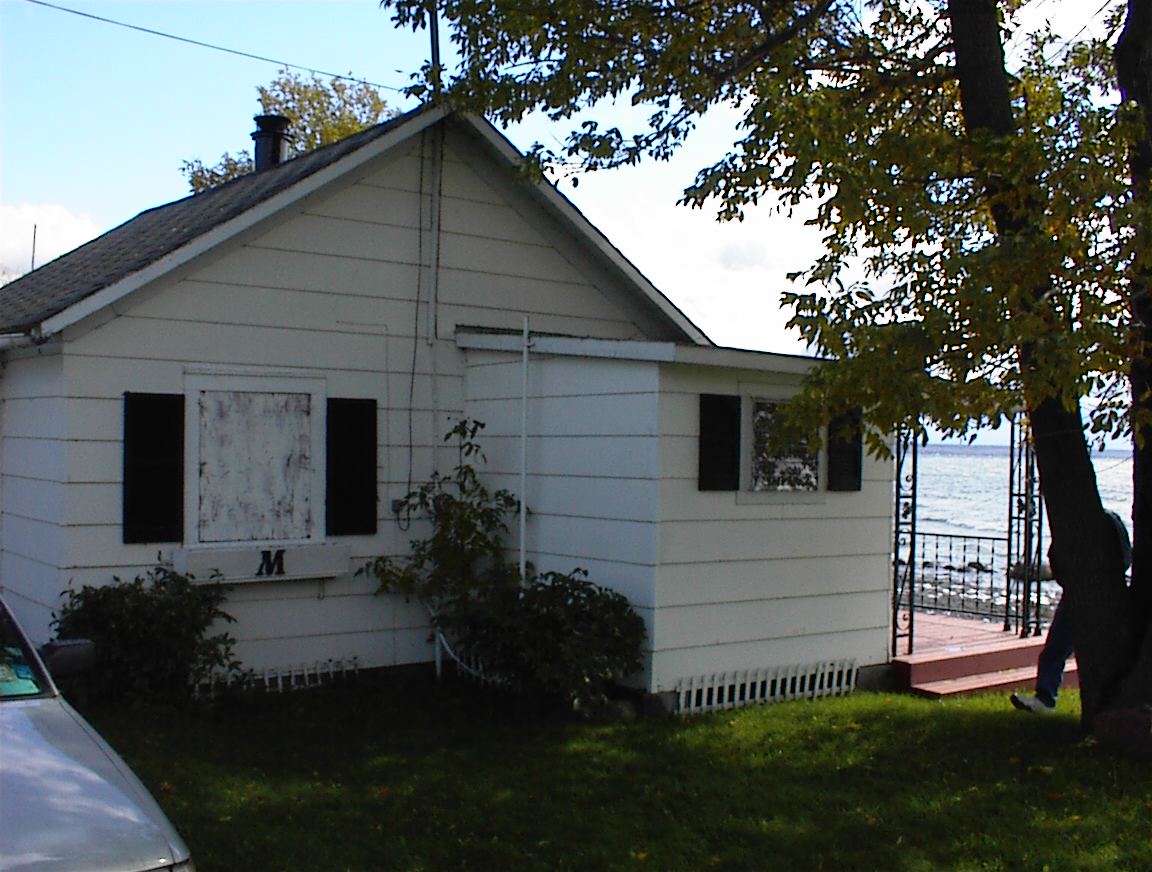
With his newfound free time, Leon made daily trips to the cottage during the warmer months, often accompanied by Ruth. Though they never stayed overnight—Ruth preferred the comfort of their home—the cottage served as a gathering place for family activities and relaxation. Each evening, as the sun began to set, Leon would take his small aluminum rowboat onto the lake, casting lines in pursuit of bass. Fishing became a beloved ritual, offering Leon a chance to unwind and enjoy the tranquility of nature. He would bring his catch back, clean the fish himself, and savor the meal as part of his connection to the land and water he loved.
New Vehicles and Practical Changes
As Leon and Ruth settled into their retirement years, they adapted their lifestyle with practical choices in vehicles. Leon became a regular buyer of Ford Escort station wagons, appreciating their reliability and storage space, perfect for hauling supplies to and from the cottage. He bought a grey Ford Escort station wagon in 1993, followed by a red one in 1997, each time passing his previous car down to his son, Leon Jr., a gesture that reflected his pragmatic nature.
In 1997, Ruth also upgraded her vehicle, trading in her 1977 Thunderbird—a car she had driven for two decades—for a brand-new red Dodge Neon. This change marked a shift in their lifestyle; the Neon was simpler and more economical, aligning well with their focus on comfort and ease in retirement.
Long Walks and Time Together
With the freedom retirement provided, Leon and Ruth began a new tradition: long walks from their home into downtown Watertown. These strolls, lasting over an hour, allowed them to explore the town, enjoy each other’s company, and engage with the local community. They would walk around Watertown’s central square, taking in the sights and sounds before making their way back home. This was a new routine they hadn’t followed before retirement, adding a shared activity that kept them active and connected to their surroundings.
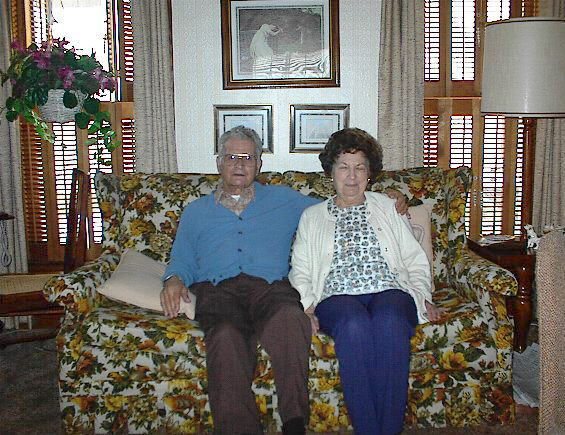
Winters in Sarasota, Summers on the Lake
As they grew older, Leon and Ruth began spending winters in Sarasota, Florida, visiting their son Tim and his family. This seasonal migration provided a welcome escape from the harsh Watertown winters, allowing them to enjoy Florida’s warmth and sunshine. Leon developed a close relationship with his grandson, Jason Maiolo, creating bonds that enriched his later years. Summers remained devoted to the cottage on Lake Ontario, where they continued to enjoy the familiar routines of fishing, landscaping, and relaxation. This seasonal rhythm brought variety to their retirement, balancing the comforts of home with new experiences in Florida.
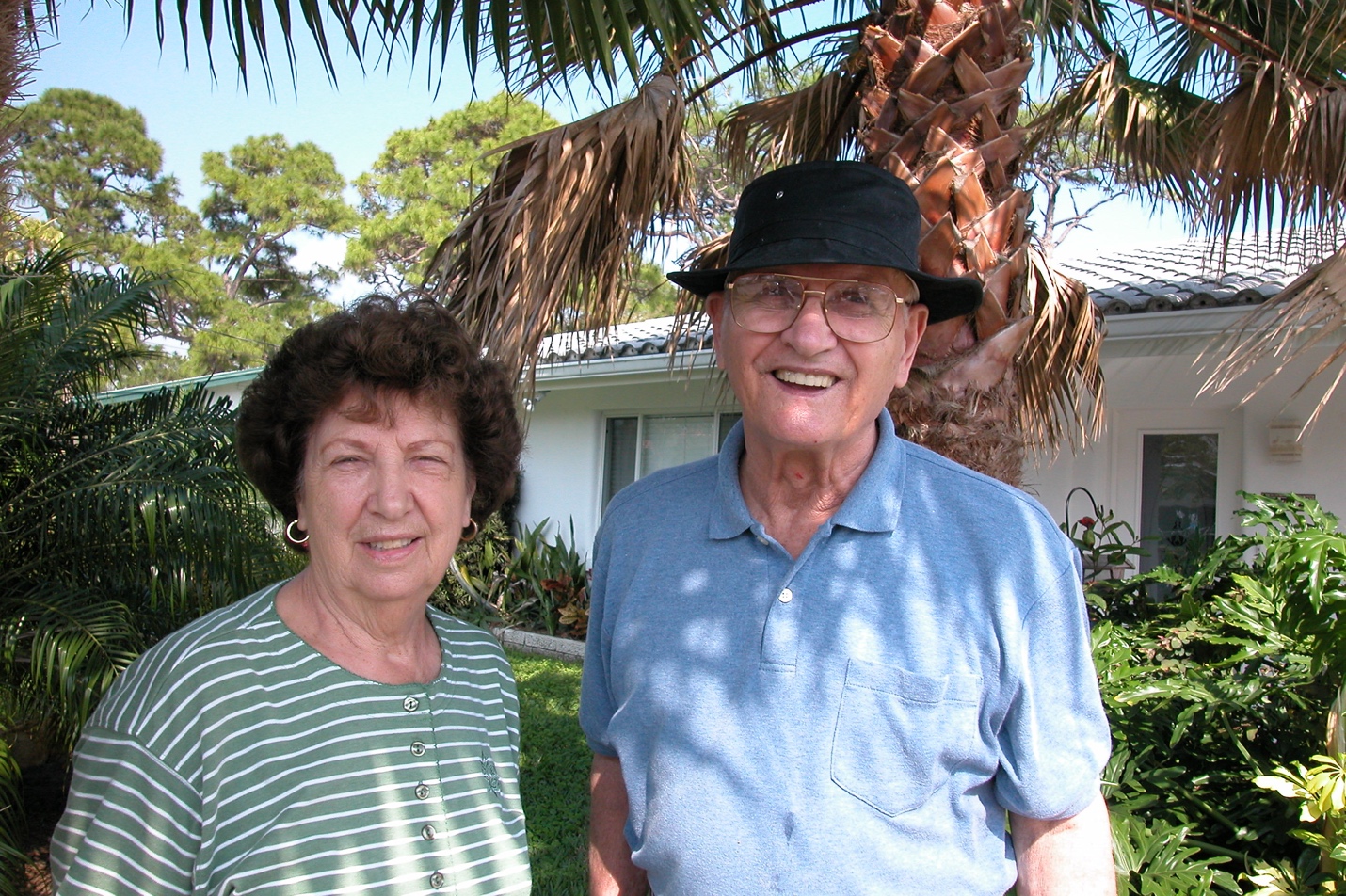
Hunting at Camp Drum
Throughout his retirement, Leon continued to enjoy hunting, a tradition he had cherished since his youth. Although his hunting partner, brother-in-law Bill, had passed away in the 1970s, Leon still pursued this activity alone, often visiting Camp Drum (now called Fort Drum) in the Watertown area. These solitary hunting trips reflected his enduring self-reliance and connection to nature. Hunting allowed him to maintain a skill he had developed over a lifetime, providing both a sense of purpose and a connection to the land that had been central to his life.
Health Decline and Final Years
In his late 70s, Leon’s health began to decline as he was diagnosed with Alzheimer’s disease. Over the next four to five years, the disease progressed, affecting his memory and cognition. By the early 2000s, his condition had worsened to the point that he required full-time care. Eventually, he moved into a skilled nursing facility in Sarasota, Florida, to receive the specialized support he needed. His final months were spent close to family, who provided comfort and companionship during his final days.
Leon passed away Jan 19, 2004 in Sarasota, surrounded by his loved ones. His retirement years, marked by quiet pursuits, family time, and an enduring connection to the outdoors, reflected the values he held dear throughout his life. His legacy of hard work, resilience, and loyalty lives on in the stories, traditions, and values he left behind for his family to cherish.
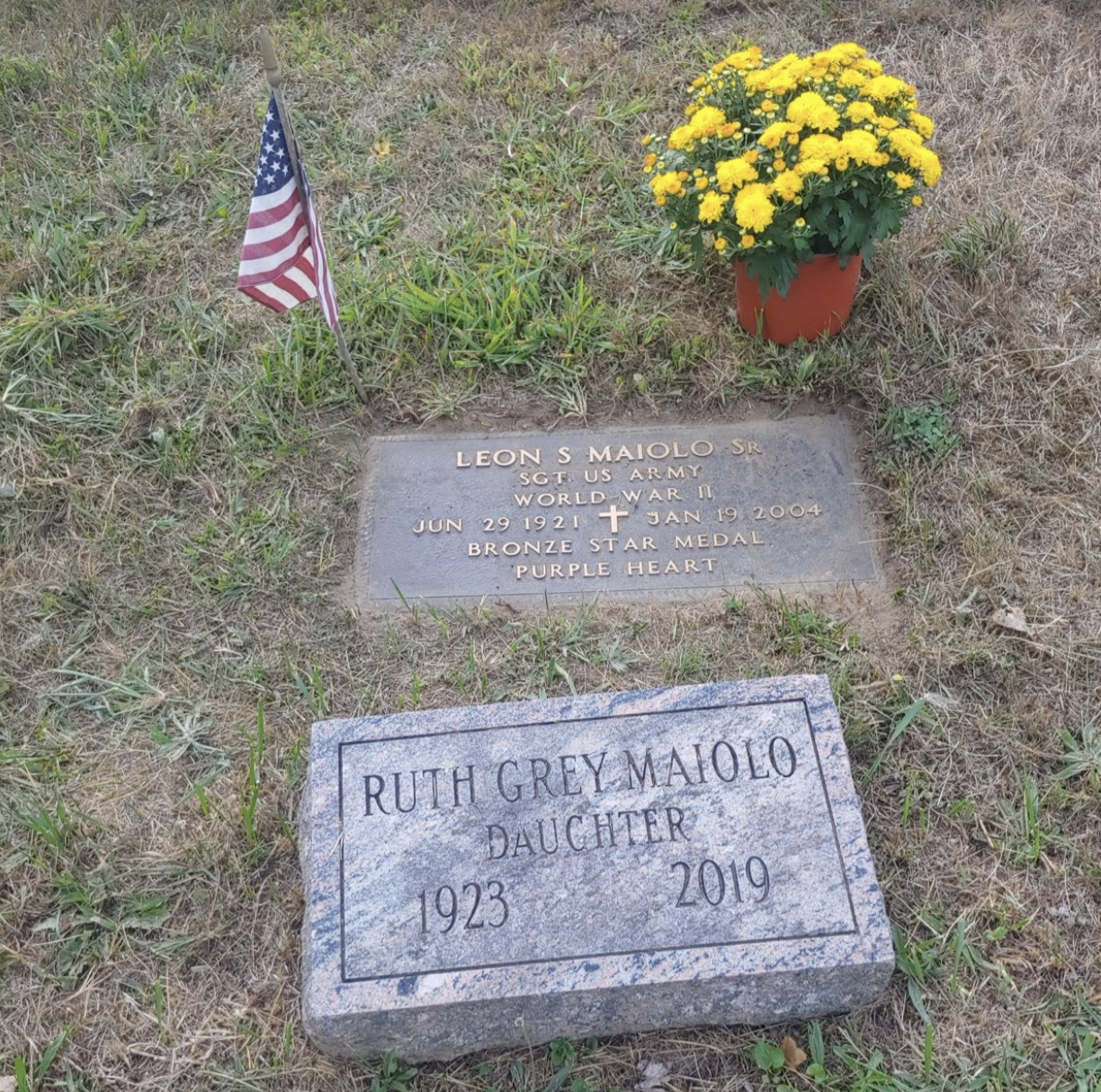
Leon’s Final Resting Place, Northside Cemetery in Watertown, NY
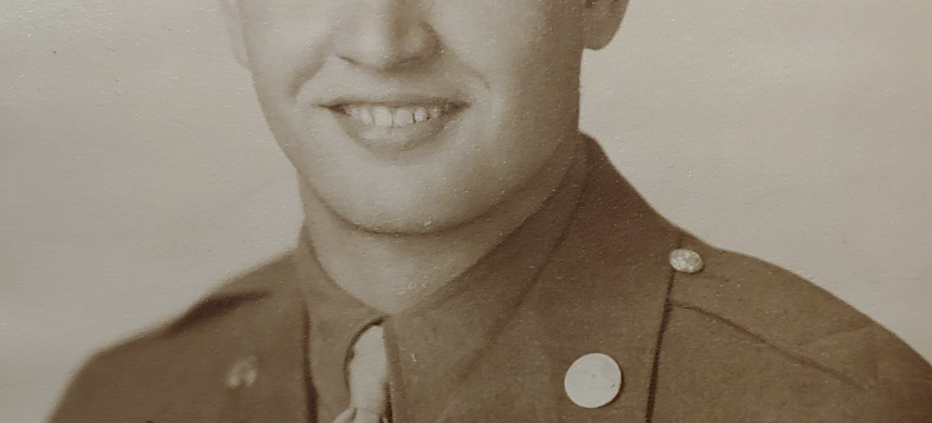


Leave a Reply
Want to join the discussion?Feel free to contribute!